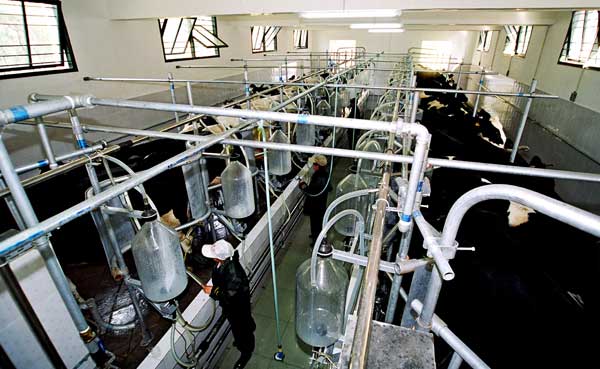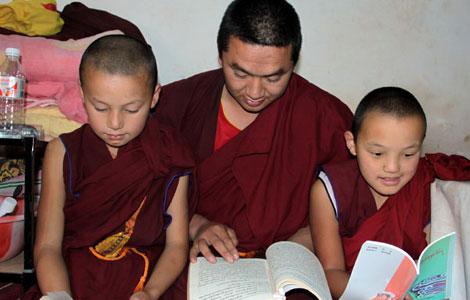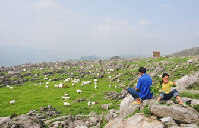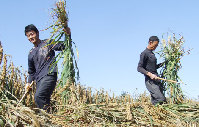Pastures are now alive
Updated: 2013-11-28 10:00
By Sun Yuanqing (China Daily)
|
||||||||
 |
|
The farm also boasts fresh milk by free-range cows. |
Huge potential
The farm has so far developed more than 1,133 hectares of pasture, on which more than 600 Holstein cows, 200 Corriedale sheep and 350 goats are raised.
Every year, it produces 30 tons of grass seeds and 1,800 tons of milk. The farm is also working with more than 100 local farmers, who raise another 1,000 cows.
Lu Mingqiong, a former corn farmer, began to raise cows in 2004. Starting with two cows, she now has 33, which bring her at least 80,000 yuan ($13,109) profit a year.
| Bleat of the hybrid ushers in new era |
| Seeds of hope |
"By raising cows for a month, I earned as much as growing corn for a whole year," Lu says. "For the first few months, we lost money. It wouldn't have been possible without the support from the farm."
Lu and her husband take care of more than 6.7 hectares of grassland on the farm. All the grass seeds and fertilizers are free. Whenever they have a question, they call the technicians for help.
When 24-hour grazing is not possible during the summer months, the farmers make up for it with self-made silage and hay.
Because the grazing animals get more exercise than those reared in pens, they produce 20 kilograms of milk one day, only one-third the amount of the pen-reared animals.
"But as long as the quality of the milk meets our standard, the farmers' returns are guaranteed," says Wang Yingfen, deputy director of the farm.
Every day the farm collects the milk from farmers like Lu, processes and sells on their behalf. It purchases the milk for 7.6 yuan per kilogram, regardless of fluctuations of the market price, which is currently about 6 yuan.
While the farm is equipped with cultivation and harvesting machinery, it is still considered to have big potential in terms of technology, says Ross de Clifford, an agriculture major from Massey University who came to Dushan in September to give a two-week training course in dairy to local farmers.
"China reminds me of what New Zealand was 50 years ago. The technologies used are very limited and they are not cost-effective," De Clifford says.
The Dushan farm has more than 70 people working on it, but much less labor would be used in New Zealand for the same amount of work as most labor would be replaced by machinery, he says.
"In the next 10 years, the biggest area of improvement for Chinese farms is in technology, such as effective fencing. It's a good thing that the farm is now changing from steel fence to electric fence, which is easier to control," De Clifford says.
Su Jiangyuan and Li Jun contributed to the story.
Related: Time line
For more Eco China, here

 Post-baby Duchess
Post-baby Duchess
 Victoria Beckham S/S 2014 presented during NYFW
Victoria Beckham S/S 2014 presented during NYFW
 'Despicable' minions upset Depp's 'Lone Ranger' at box office
'Despicable' minions upset Depp's 'Lone Ranger' at box office
 'Taken 2' grabs movie box office crown
'Taken 2' grabs movie box office crown
 Rihanna's 'Diamonds' tops UK pop chart
Rihanna's 'Diamonds' tops UK pop chart
 Fans get look at vintage Rolling Stones
Fans get look at vintage Rolling Stones
 Celebrities attend Power of Women event
Celebrities attend Power of Women event
 Ang Lee breaks 'every rule' to make unlikely new Life of Pi film
Ang Lee breaks 'every rule' to make unlikely new Life of Pi film
Most Viewed
Editor's Picks

|

|

|

|

|

|
Today's Top News
Biden’s China trip has broad agenda
Premier carries hectic schedule
China to be largest oil importer
Clean energy fueling the future
Ancient Chinese philosophies are eye-opening
Tencent anti-monopoly suit trial starts in Beijing
US B-52 bombers in air zone monitored
Court rejects appeal of military singers' son
US Weekly

|

|








